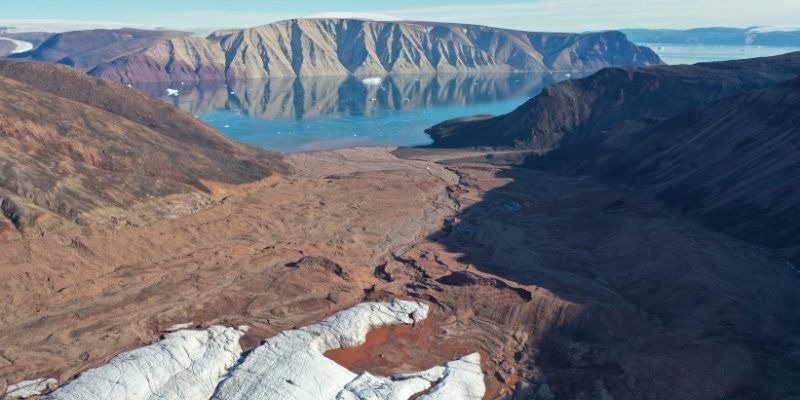A comprehensive examination of historical satellite data reveals that approximately 11,000 square miles or 28,707 square kilometers of Greenland's ice sheet and glaciers have melted over the past 30 years.
 Above Sydgletscher looking to Bowdoin Fjord, at Qaanaaq, north-west Greenland. Image Credit: Mark Smith.
Above Sydgletscher looking to Bowdoin Fjord, at Qaanaaq, north-west Greenland. Image Credit: Mark Smith.
This extensive ice loss is equivalent to the land area of Albania and constitutes approximately 1.6% of Greenland's overall ice and glacier coverage.
In the areas where ice and snow once dominated, barren rock, wetlands, and patches of shrubbery now prevail.
A group of researchers from the University of Leeds has meticulously monitored the transformations across Greenland from the 1980s to the 2010s. Their findings indicate that rising air temperatures are prompting the retreat of ice, consequently influencing land surface temperatures, greenhouse gas emissions, and landscape stability.
The warming trend is causing the degradation of permafrost, a permanently frozen layer beneath the Earth's surface. In certain regions, this degradation poses a potential threat to infrastructure, buildings, and local communities situated above it, as cautioned by scientists.
The study was published in the journal Scientific Reports.
Impact of Global Warming
Greenland, situated within the Arctic region, holds the distinction of being the world's largest island, spanning approximately 836,330 square miles (2.1 million square kilometers). The majority of its terrain is enveloped by vast expanses of ice and glaciers, while it is inhabited by nearly 57,000 individuals.
Notably, since the 1970s, the Arctic has experienced warming at a rate twice as fast as the global average. Specifically, in Greenland, the average annual air temperatures surged by 3 ºC between 2007 and 2012, in contrast to the average recorded between 1979 and 2000.
Furthermore, researchers caution that the likelihood of more extreme temperatures in the future is high.
Warmer temperatures are linked to the land cover changes that we are seeing on Greenland. By analyzing high resolution satellite images, we have been able to produce a detailed record of the land cover changes that are taking place.
Jonathan Carrivick, Study Author and Earth Scientist, Faculty of Environment, University of Leeds
Ice Disappears to be Replaced by Bare Rock and Shrubs
Ice loss was particularly pronounced along the peripheries of existing glaciers, extending to the northern and southwestern regions of Greenland. Additionally, substantial ice loss occurred in localized zones in the western, mid-northwestern, and southeastern areas.
Over the course of three decades, the extent of land covered by vegetation witnessed a remarkable expansion, increasing by 33,774 square miles (87,475 square kilometers), more than doubling during the study period.
A significant surge in vegetation was observed throughout the southwestern, eastern, and northeastern regions of Greenland. Particularly noteworthy was the substantial growth of dense wetland vegetation, notably near Kangerlussuaq in the southwest and in isolated pockets in the northeast.
Through their analysis, researchers determined that vegetation expansion followed a latitudinal gradient, peaking between 63ºN and 69ºN while declining further north of this range.
We have seen signs that the loss of ice is triggering other reactions which will result in further loss of ice and further ‘greening’ of Greenland, where shrinking ice exposes bare rock that is then colonized by tundra and eventually shrub. At the same time, water released from the melting ice is moving sediment and silt, and that eventually forms wetlands and fenlands.
Jonathan Carrivick, Study Author and Earth Scientist, Faculty of Environment, University of Leeds
Loss of ice Triggers Further Warming
The depletion of ice significantly impacts land surface temperatures due to albedo, which quantifies the reflectivity of a surface. Snow and ice serve as effective reflectors of the sun's energy striking the Earth's surface, contributing to the cooling of the planet.
However, as the ice recedes, it unveils bedrock that absorbs more solar energy, consequently elevating the temperature of the land surface. This shift in albedo exacerbates the warming trend in the affected regions.
As ice melts, it augments the water volume in lakes. Water absorbs more solar energy compared to snow, further raising the land surface temperature.
Greenhouse Gas Emitter
The analysis indicates a nearly fourfold increase in wetlands across Greenland, notably concentrated in the eastern and northeastern regions. These wetlands serve as sources of methane emissions.
“Expansion of vegetation and especially in wetland areas indicates but also exacerbates permafrost thaw, active layer thickening and thus emissions of greenhouse gases previously stored in these Arctic soils,” the researchers added.
Additionally, the researchers devised a model to forecast the regions in Greenland that are expected to experience "significant and accelerated" transformations in the future.
The expansion of vegetation, occurring in tandem with the retreat of glaciers and the ice sheet, is significantly altering the flow of sediments and nutrients into coastal waters. These changes are critical, particularly for the indigenous populations whose traditional subsistence hunting practices rely on the stability of these delicate ecosystems. Moreover, the loss of ice mass in Greenland is a substantial contributor to global sea level rise, a trend that poses significant challenges both now and in the future.
Michael Grimes, Study Lead Author, University of Leeds
Journal Reference:
Grimes, M., et al. (2024). Land cover changes across Greenland dominated by a doubling of vegetation in three decades. Scientific Reports. doi.org/10.1038/s41598-024-52124-1.